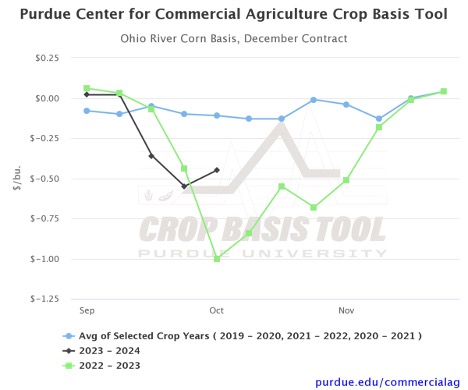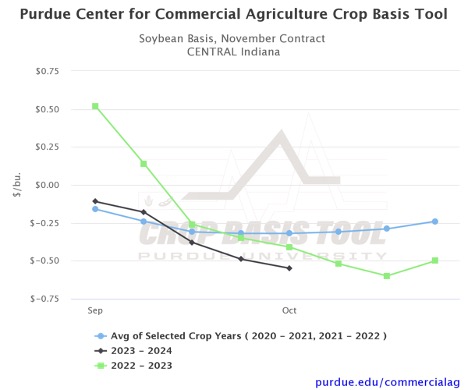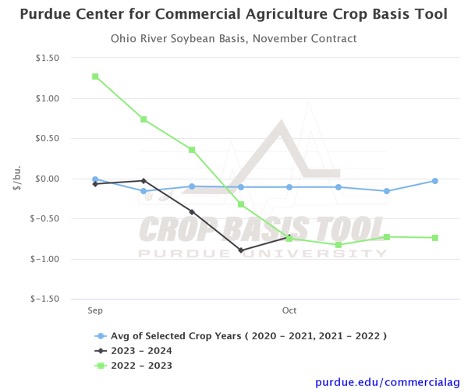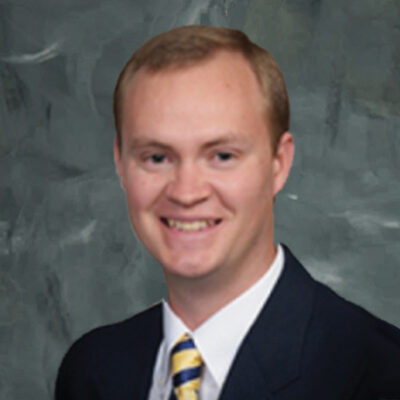October 5, 2023
Corn and Soybean Basis Weaken as Harvest Heats Up
by Nathanael Thompson
As harvest heats up across the Midwest corn and soybean basis have been weakening. Weakening basis during harvest is typical of seasonal basis patterns. Therefore, to give context to current basis levels it is helpful to compare them to historical basis levels. For example, looking at the 2019-2020, 2020-2021, and 2021-2022 crop marketing years, corn basis in Central Indiana declined by $0.31/bu. on average from the first week of September to the first week of October (blue line in Figure 1). However, notice that corn basis last year declined by more than $0.50/bu. over this same time period (green line in Figure 1). Weaker than normal basis last fall was largely influenced by transportation disruptions caused by low Mississippi River levels. Low river levels are again a factor in the fall of 2023. As a result, corn basis levels in Central Indiana are tracking 2022 basis levels nearly identically (black line in Figure 1).

Figure 1. Corn Basis, December Contract Central Indiana, Purdue Center for Commercial Agriculture Crop Basis Tool
Looking at corn basis levels for terminals along the Ohio River paints a slightly different picture (Figure 2). While current basis levels are much weaker than normal—basis during the first week of October is $-0.45/bu. compared to an average of -$0.11/bu. during the 2019-2020, 2020-2021, and 2021-2022 crop marketing years—notice that basis appears to have firmed this week and is $0.55/bu. stronger than the same date last year.

Figure 2. Ohio River Corn Basis, December Contract, Purdue Center for Commercial Agriculture Crop Basis Tool
The story for soybean basis is similar. Soybean basis in Central Indiana has declined by $0.66/bu. from the first week of September to the first week of October 2023 (black line in Figure 3). As a result, current soybean basis for the first week of October—$0.55/bu. under November 2023 soybean futures—is $0.14/bu. weaker than the same week last year and $0.23/bu. weaker than the two-year average of the 2020-2021 and 2021-2022 crop marketing years.

Figure 3. Soybean Basis, November Contract Central Indiana, Purdue Center for Commercial Agriculture Crop Basis Tool
However, similar to corn, soybean basis at terminals along the Ohio River have actually firmed this week (Figure 4). Nonetheless, soybean basis at these locations—currently $0.73/bu. under November 2023 soybean futures—are $0.62/bu. weaker than the two-year average of the 2020-2021 and 2021-2022 crop marketing years and very similar to soybean basis at these locations for the same week last year.

Figure 4. Ohio River Soybean Basis, November Contract, Purdue Center for Commercial Agriculture Crop Basis Tool
Corn and soybean basis levels typically reach their seasonal lows during the month of October. However, it is important to point out that river levels are not projected to improve over the next month. Therefore, the risk of lower basis levels remains yet this fall.
Visit the Purdue Crop Basis Tool to check current corn and soybean basis levels and historical basis trends for your local area.
TAGS:
TEAM LINKS:
RELATED RESOURCES
UPCOMING EVENTS
December 1 & 8, 2025
Join Purdue Extension for a two-part workshop designed to help you gain a clearer understanding of tax planning essentials. The first session on December 1 will focus on the fundamentals of farm taxes, with particular emphasis on strategies that can be used in a low net income year. The second session on December 8 will focus on key tax strategies and will allow plenty of time for questions. Registration cost is only $20.
Read MoreDecember 15, 2025
This program provides in-depth coverage of agricultural and farm tax issues. In addition to covering timely tax issues, we will cover disaster tax issues, depreciation and expensing farm assets, retirement planning for farms, and tax planning in low-income years. This year’s webinar will be co-taught by a team from Ohio State and Purdue Universities.
Read MoreJanuary 27 or 28, 2026
Farm Shield is more than a conference, it’s a commitment to helping agricultural families build resilience and plan for a secure future. Don’t miss this opportunity to protect your legacy!
Read More